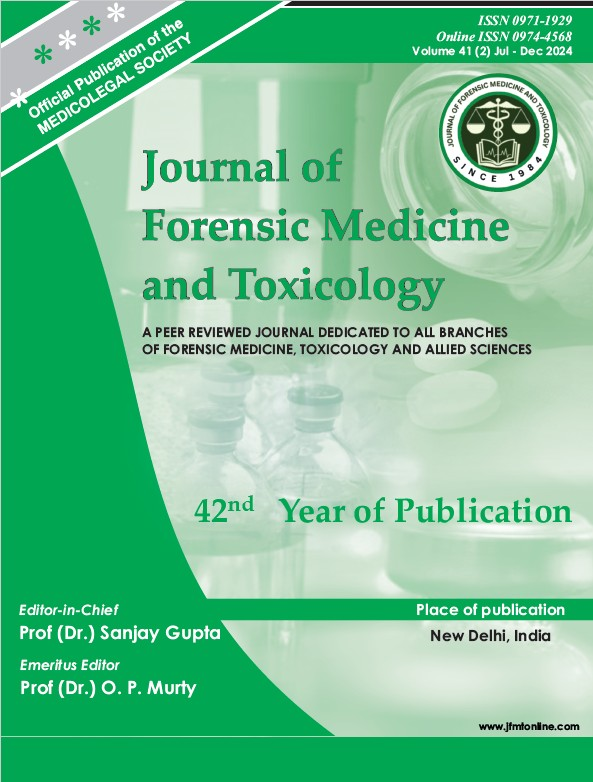MONONUCLEAR NICKEL COMPLEXES OF ORGANOSELENIUM SCHIFF BASE MACROCYCLES: SYNTHESIS AND CHARACTERIZATION
DOI:
https://doi.org/10.48165/jfmt.2024.41.2.32Keywords:
Organoselenium Substituted Metal Organic Framework, Tetradentate ligand, Monometallic Ni(II) Complex, Cyclic voltammetryAbstract
Synthesis of organoselenium multidentate ligands having 24- and 28-membered ring in dry acetonitrile under inert atmosphere has been carried out and studied their reactivity towards NiCl2. The reaction has been carried out at room temperature. These ligands on coordination with NiCl2 in, 1:2 molar ratio in CH3OH, its produced green colored compound 1 and 2. The mononuclear complexes 1 and 2 are found to have [Se{(CH2)nN=CPhC6H2(O)(4-CH3)PhC=O}2Ni] (where n = 2, 3) molecular composition with the elimination of CH3COOH and bis(aminoalkyl) selenide. The above compound 1and 2, Ni(II) binds in a bidentate mode (N2O2) after the hydrolysis of two azomethine bonds (C=N) of the Schiff base compound. The complexes 1 and 2 have been characterized by various spectroscopic techniques such as ESIMS, IR, UV-Visible, cyclic voltammeter and conductance measurements.
Downloads
References
Zhang L, Fakhouri SM, Liu F, Timmons JC, Ran NA, Briseno AL. Chalcogenoarene semiconductors: New ideas from old materials. Journal of Materials Chemistry. 2011;21(5):1329–1337.
Gao D, Hollinger J, Seferos DS. Selenophene thiophene block copolymer solar cells with thermostable nanostructures. ACS Nano. 2012;6(8):7114–7121.
Ding Z, Bux SK, King DJ, Chang FL, Chen TH, Huang SC, Kaner RB. Lithium intercalation and exfoliation of layered bismuth selenide and bismuth telluride. Journal of Materials Chemistry. 2009;19(17):2588–2592.
Lana-Villarreal T, Font-Sanchis E, Sastre-Santos Ã, Fernández-Lázaro F, Gõmez R. Characterization and polymerization of thienylphenyl and selenylphenyl amines and their interaction with CdSe quantum dots. ChemPhysChem. 2011;12(6):1155–1164.
Potapov VA, Amosova S V. New methods for preparation of organoselenium and organotellurium compounds from elemental chalcogens. Russian journal of organic chemistry. 2003;39(10):1373–1380.
Turner EA, Rösner H, Huang Y, Corrigan JF. Accessing HgSe x S 1-x nanoparticles using the single-source reagent Me3Si-SeS-SiMe3. Journal of Cluster Science. 2007;18(3):764–771.
Wirth T. Organoselenium chemistry: synthesis and reactions. John Wiley & Sons; 2012.
Armarego WLF, Chai CLL. Purification of Laboratory Chemicals. 2013.
Mandal SK, Nag K. Dinuclear metal complexes. Part 2. Synthesis, characterisation, and electrochemical studies of macrocyclic dicopper (II) complexes. Journal of the Chemical Society, Dalton Transactions. 1983;(11):2429–2434.
Milton MD, Khan S, Singh JD, Mishra V, Khandelwal BL. A facile access to chalcogen and dichalcogen bearing dialkylamines and diols. Tetrahedron Letters. 2005;46(5):755–758.
Verma VK. Selenium bearing 24- & 28-membered macrocyclic Schiff bases/ : Synthesis and electrochemical behaviour International Journal of Current Advanced Research. 2019;(June):11–14.
Nakamoto K. Infrared and Raman Spectra of Inorganic and Coordination Compounds: Part B: Applications in Coordination, Organometallic, and Bioinorganic Chemistry. Infrared and Raman Spectra of Inorganic
and Coordination Compounds: Part B: Applications in Coordination, Organometallic, and Bioinorganic Chemistry. 2008 Apr 30:1–408.
Chattopadhyay S, Chakraborty P, Drew MGB, Ghosh A. Nickel(II) complexes of terdentate or symmetrical tetradentate Schiff bases: Evidence of the influence of the counter anions in the hydrolysis of the imine bond in Schiff base complexes. Inorganica Chimica Acta. 2009;362(2):502–508.
Czaun M, Nelana SM, Guzei IA, Hasselgren C, Hkansson M, Jagner S, Lisensky G, Darkwa J, Nordlander E. An investigation of Cu(II) and Ni(II)- catalysed hydrolysis of (di)imines. Inorganica Chimica Acta. 2010;363(12):3102–3112.
Naghski DH, Boyd JT, Jackson HE, Steckl AJ. Macrocyclic Nickel Complexes in DNA Recognition and Oxidation. 1998;65(May):98–101.
Kahwa IA, Fronczek FR, Selbin J. Partial hydrolysis of homodinuclear macrocyclic complexes of lanthanides with a 2:2 phenolic schiff’s base and the crystal and molecular structure of resulting open mononuclear 3:1 schiff’s base complexes of praseodymium(III) and neodymium(III). Inorganica Chimica Acta. 1988;148(2):273–281.
Lim IT, Choi KY. One-dimensional hydrogen-bonded
infinite chain from nickel(II) tetraaza macrocyclic complex and 1,2-cyclopentanedicarboxylate ligand. International Journal of Molecular Sciences. 2011;12(4):2232–2241.
Maganas D, Grigoropoulos A, Staniland SS, Chatziefthimiou SD, Harrison A, Robertson N, Kyritsis P, Neese F. Tetrahedral and square planar Ni[(SPR2)2N] 2 complexes, R = Ph &iPr revisited: Experimental and theoretical analysis of interconversion pathways, structural preferences, and spin delocalization. Inorganic Chemistry. 2010;49(11):5079–5093.
Bhasin CP, Panchal DG. First approach towards some novel macrocyclic complexes having mixed ligands: Dialkyldithiophosphate derivatives of some Ni(H) macrocyclic complexes having N2S2 potential donors in 14 to 20-membered rings. Synthesis and Reactivity in Inorganic, Metal-Organic and Nano-Metal Chemistry. 2005;35(3):213–225.
Liaw WF, Horng YC, Ou DS, Ching CY, Lee GH, Peng SM. Distorted square planar Ni(II)- chalcogenolate carbonyl complexes [Ni(CO)(SPh(n) (SePh) (3-n)]- (n = 0, 1, 2): Relevance to the nickel site in CO dehydrogenases and [NiFeSe] hydrogenase. Journal of the American Chemical Society. 1997;119(39):9299–9300.




